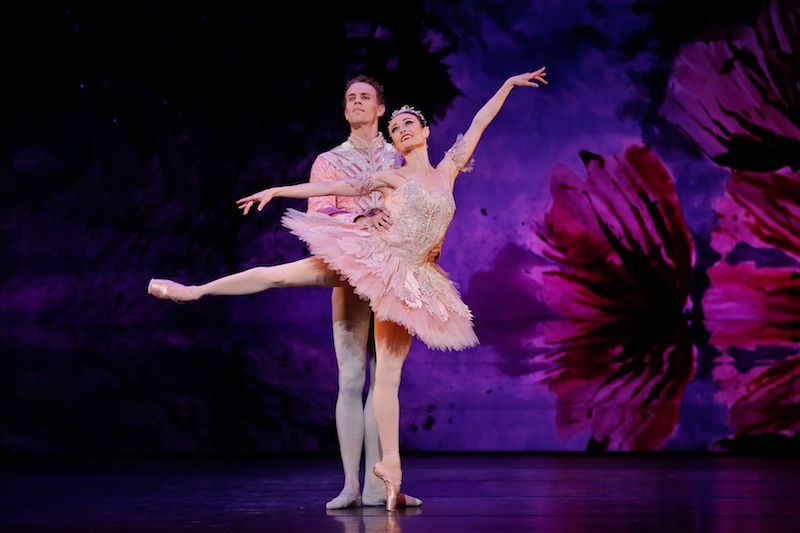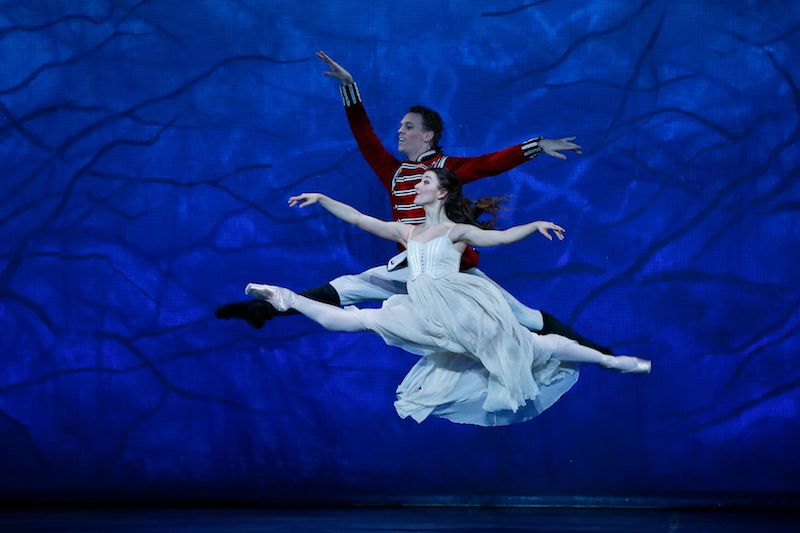The Christmas season seems to have begun early for The Australian Ballet, which has opened its Melbourne run of Peter Wright’s The Nutcracker. It’s a familiar work for both the company and audiences. The perennial favourite delivers most of what it promises: a fantasy showpiece wrapped in lavish designs by John F Macfarlane, accompanied by a charismatic rendering of Tchaikovsky’s score.

Adam Bull and Amber Scott. Photograph © Jeff Busby
This 1990 version of the work by British choreographer Wright is his second, after his first attempt had limited success. The story of Clara, who receives a magical Nutcracker doll on Christmas Eve, which triggers a series of dreamed adventures, remains intact. But Wright has sought to amplify the magical themes of the work, reimagining Drosselmeyer’s character as a magician (rather than Clara’s uncle) and introducing a Snow Fairy.
But even with minor changes like this, the plot of The Nutcracker is still inescapably thin. Character depth and dramatic tension are in short supply, and the second act is mostly spectacle. This is not a new observation. Similar criticisms have plagued the ballet since its original, lukewarm premiere in 1892.
The strength of the work is, of course, Tchaikovsky’s iconic score, which Wright has leveraged to his full advantage. The music is melodic and richly detailed, and the choreography crafted to suit it.
Particularly cinematic is the battle scene between the rat army and tin soldiers, created by assistant choreographer Vincent Redmon. Our focus shifts rapidly between the two sides as the action unfolds, creating compositional depth. Here, the movement helps develop the narrative, not just decorate it.
Senior artist Benedicte Bemet danced a very musical Clara on opening night, her weightless arabesques and balances filling out every moment of the music. Bemet, who first played the role in 2014, did well to find some dramatic depth in her character, but her youthful physicality and beautiful phrasing were most striking.
 Adam Bull and Benedicte Bemet. Photograph © Jeff Busby
Adam Bull and Benedicte Bemet. Photograph © Jeff Busby
Principal Amber Scott also returned to the role of the Sugar Plum Fairy, executing the challenging Act II divertissements with clear line and effortless control. Leading the well-drilled corps of Snowflakes was soloist Nicola Curry, who gave a commendable performance as the Snow Fairy, dancing with confidence and precision. Indeed, the whole cast danced well. Save for a few stumbles and untidy unison in the Waltz of the Flowers, the work sat comfortably on the company.
And so it should. The Nutcracker is a creature of longevity and repetition. Dancers and audiences return to the work, year after year; drawn to its music, the tradition or pure spectacle. These motivations seem inoculated from the enduring criticism of the libretto and structure.
While not every ballet needs to push the artform forward, it certainly shouldn’t be dragging it backwards. Wright’s version of the “Tea” divertissement in Act II continues to present racialised stereotypes of Chinese characters, complete with Fu Manchu moustaches, upward pointing index fingers and fast shuffling runs. The characters are cartoonish and one-dimensional, and seemingly the only obvious “joke” in the whole ballet.
Some versions of The Nutcracker, especially in the United States, have diluted the racial caricatures, but there is a push to do more. Petitions like ‘Final Bow for Yellowface’ (led by New York City Ballet dancers and endorsed by dozens of major ballet companies around the world) have prompted major rewrites of the scene, even in Balanchine’s version which NYCB has performed every year since 1954.
The fact that Wright’s production, which has been in The Australian Ballet’s repertoire since 2007, seems ignorant of this conversation is problematic. There’s only so much artistic mileage you can get out of “tradition”. Hopefully when The Nutcracker makes its inevitable return, it will be welcoming to more audiences.












Comments
Log in to join the conversation.